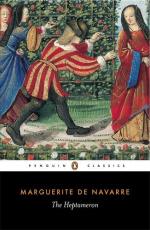Now I heard not long since that the two ladies I have mentioned, together with several others of the Court, determined to do like Boccaccio, with, however, one exception—they would not write any story that was not a true one. And the said ladies, and Monseigneur the Dauphin with them, undertook to tell ten stories each, and to assemble in all ten persons, from among those whom they thought the most capable of relating something. Such as had studied and were people of letters were excepted, for Monseigneur the Dauphin would not allow of their art being brought in, fearing lest the flowers of rhetoric should in some wise prove injurious to the truth of the tales. But the weighty affairs in which the King had engaged, the peace between him and the King of England, the bringing to bed of the Dauphiness,(13) and many other matters of a nature to engross the whole Court, caused the enterprise to be entirely forgotten.
13 The confinement mentioned here is that of Catherine de Medici, who, after remaining childless during ten years of wedlock, gave birth to a son, afterwards Francis II., in January 1543. The peace previously spoken of would appear to be that signed at Crespy in September 1544. Both M. de Montaiglon and M. Dillaye are of opinion, however, that a word or two is deficient in the MS., and that Margaret intended to imply the rupture of peace in 1543, when Henry VIII. allied himself with the Emperor Charles V. against Francis I.—Ed.
By reason, however, of our now great leisure, it can be accomplished in ten days, whilst we wait for our bridge to be finished. If it so pleased you, we might go every day from noon till four of the clock into yonder pleasant meadow beside the river Gave. The trees there are so leafy that the sun can neither penetrate the shade nor change the coolness to heat. Sitting there at our ease, we might each one tell a story of something we have ourselves seen, or heard related by one worthy of belief. At the end of ten days we shall have completed the hundred,(14) and if God wills it that our work be found worthy in the eyes of the lords and ladies I have mentioned, we will on our return from this journey present them with it, in lieu of images and paternosters,(15) and feeling assured that they will hold this to be a more pleasing gift. If, however, any one can devise some plan more agreeable than mine, I will fall in with his opinion.”
14 This passage plainly
indicates that the Queen meant to
pen a Decameron.—Ed.




